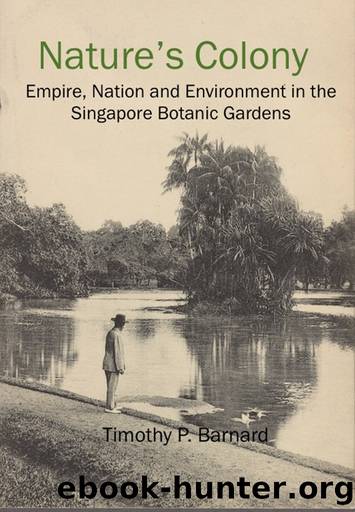Nature's Colony by Timothy P. Barnard

Author:Timothy P. Barnard [Barnard, Timothy P.]
Language: eng
Format: epub
ISBN: 9789814722452
Published: 0101-01-01T00:00:00+00:00
Through these efforts, and those of his successors, Burkill added 20,000 new specimens to the herbarium, and these form the core of the current collection, which is considered to be one of the most important scientific legacies of the Singapore Botanic Gardens.62
The culmination of many of these changes was the completion of a reconstructed herbarium in January 1930, five years after Burkill retired. The herbarium was now a two-story building. The general collection was stored in seven double ranks of 12 teak cases, ultimately consisting of 84 storage units. The remaining space on the ground floor consisted of sorting tables. The second floor contained cultivated plants, the spirit collection and museum specimens, as well as an open space in the center of the building that looked down into the first floor.63 From this systematic organization of Malayan flora emerged important taxonomic research that reflected a shift in the role the Singapore Botanic Gardens played in the collection of colonial knowledge over the natural world. It now became an autonomous center, part of larger transnational networks, specializing in the collection and collation of botanical knowledge of the Malay Peninsula and surrounding regions.
The Botanical Survey of British Malaya
The ultimate manifestation of the survey modality of collecting and identifying the flora of the region was the publication of botanical surveys of British Malaya. While Joseph Hooker had included some material on Southeast Asia in his Flora of British India, and done so with the help of Cantley and Ridley, and a variety of other botanists had published specific studies on families and genera, the first dedicated flora of the region appeared over a ten-year period from 1904 until 1914 under the guidance of George King.64 This work, Materials for a Flora of the Malay Peninsula, was developed from specimens collected throughout the 19th century in Malaya, which were subsequently compiled and identified in Calcutta and Kew. King only visited Malaya once, placing him at the mercy of collectors and scientists who described the region for him. As is true with almost all taxonomic works, revision of the text was necessary as new discoveries were made. Ridley even began revising the section on monocots (one of the major groups of flowering plants) as early as 1907 while the main text continued to be published. When King died in 1909, his Materials for a Flora of the Malay Peninsula was still uncompleted. J. Sykes Gamble, a botanist formerly employed in India but living in Kew following his retirement in 1899, helped finish the work.65
Ridley took it upon himself to complete a separate flora of the region, as it would reflect not only his vast knowledge of the natural world of Malaya but also the expansion of botanical research that had taken place in herbarium at the Singapore Botanic Gardens. The subsequent workâThe Flora of the Malay Peninsulaâwas revolutionary in the depth of its content. The first volume appeared in 1922, ten years after his retirement from the Singapore Botanic Gardens, and focused on Polypetalae, a taxonomic grouping no longer used for flowers with petals that are free from their base.
Download
This site does not store any files on its server. We only index and link to content provided by other sites. Please contact the content providers to delete copyright contents if any and email us, we'll remove relevant links or contents immediately.
| Africa | Americas |
| Arctic & Antarctica | Asia |
| Australia & Oceania | Europe |
| Middle East | Russia |
| United States | World |
| Ancient Civilizations | Military |
| Historical Study & Educational Resources |
The Dawn of Everything by David Graeber & David Wengrow(1615)
The Bomber Mafia by Malcolm Gladwell(1558)
Facing the Mountain by Daniel James Brown(1484)
Submerged Prehistory by Benjamin Jonathan; & Clive Bonsall & Catriona Pickard & Anders Fischer(1401)
Tip Top by Bill James(1329)
Wandering in Strange Lands by Morgan Jerkins(1321)
Evil Geniuses: The Unmaking of America: A Recent History by Kurt Andersen(1295)
Red Roulette : An Insider's Story of Wealth, Power, Corruption, and Vengeance in Today's China (9781982156176) by Shum Desmond(1286)
The Way of Fire and Ice: The Living Tradition of Norse Paganism by Ryan Smith(1283)
Driving While Brown: Sheriff Joe Arpaio Versus the Latino Resistance by Terry Greene Sterling & Jude Joffe-Block(1262)
American Kompromat by Craig Unger(1246)
It Was All a Lie by Stuart Stevens;(1234)
F*cking History by The Captain(1220)
American Dreams by Unknown(1196)
Treasure Islands: Tax Havens and the Men who Stole the World by Nicholas Shaxson(1193)
Evil Geniuses by Kurt Andersen(1180)
White House Inc. by Dan Alexander(1149)
The First Conspiracy by Brad Meltzer & Josh Mensch(1113)
The Fifteen Biggest Lies about the Economy: And Everything Else the Right Doesn't Want You to Know about Taxes, Jobs, and Corporate America by Joshua Holland(1061)
